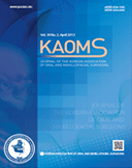Journal of the Korean Association of Oral and Maxillofacial Surgeons
- P-ISSN2234-7550
- E-ISSN2234-5930
- SCOPUS, KCI, ESCI
 ISSN : 2234-7550
ISSN : 2234-7550
Efficacy of dextrose prolotherapy on temporomandibular disorder: a retrospective study
Ku Jeong-Kui (Department of Oral and Maxillofacial Surgery, Section of Dentistry, Seoul National University Bundang Hospital, Seongnam, Korea)
Kim Young-Kyun (Department of Oral and Maxillofacial Surgery, Section of Dentistry, Seoul National University Bundang Hospital, Seongnam, Korea)
Yun Pil-Young (Department of Oral and Maxillofacial Surgery, Section of Dentistry, Seoul National University Bundang Hospital, Seongnam, KoreaDepartment of Dentistry and Dental Research Institute, School of Dentistry, Seoul National University, Seoul, Korea)
Abstract
Objectives: Dextrose prolotherapy is one of the most promising minimally invasive interventions for temporomandibular disorder (TMD), particularly in refractory cases where other conservative treatments have failed. The purpose of this study was to demonstrate the efficacy of a new treatment, temporomandibular joint (TMJ) prolotherapy, in patients with TMD to alleviate symptoms. Materials and Methods: A retrospective analysis was conducted on TMD patients with chronic pain who did not respond to conventional treatments. TMJ prolotherapy was performed using hypertonic dextrose in the TMJ area, targeting the retrodiscal attachment tissue, anterior disc attachment tissue, lateral capsule, origin of the masseter muscle, and the stylomandibular ligament. Pain or discomfort intensity in the TMJ was evaluated using a numerical rating scale (NRS). Maximum mouth opening and subjective satisfaction were also analyzed. Results: Nineteen patients (6 males, 13 females, average age 43 years) participated in this study. All patients experienced pain improvement with a maximum of three prolotherapy sessions. The initial mean NRS was 5.7, which ultimately decreased to a final mean TMJ discomfort score of 1.7 postintervention. The patients’ maximum mouth opening increased from an initial 34.5 mm to 38.8 mm, and they reported positive satisfaction with the prolotherapy treatment. The clinical outcomes were positive regardless of main origin of TMD symptoms. Conclusion: Hypertonic TMJ prolotherapy is an effective minimally invasive intervention for TMJ disorders with chronic pain.
- keywords
- Prolotherapy, Temporomandibular joint disorders, Chronic pain, Minimally invasive surgical procedures
- Downloaded
- Viewed
- 0KCI Citations
- 0WOS Citations